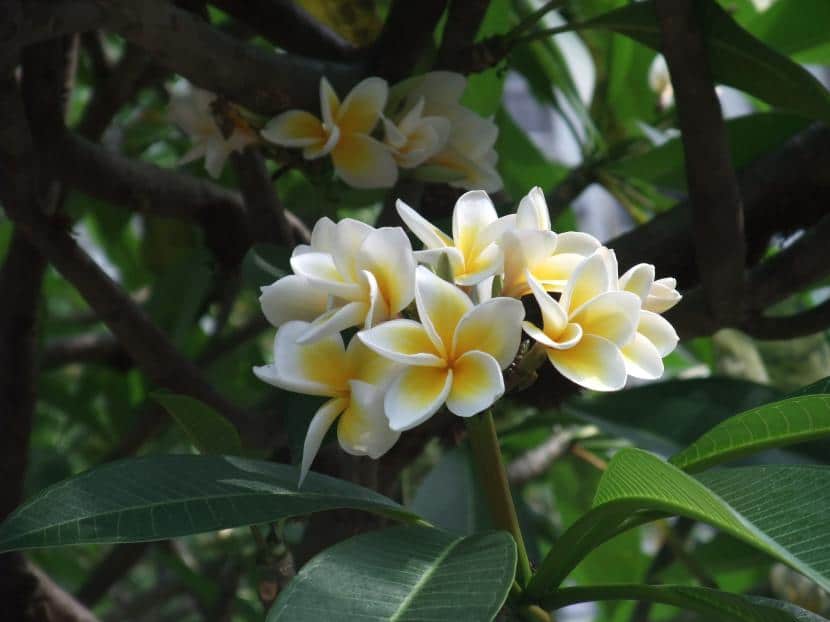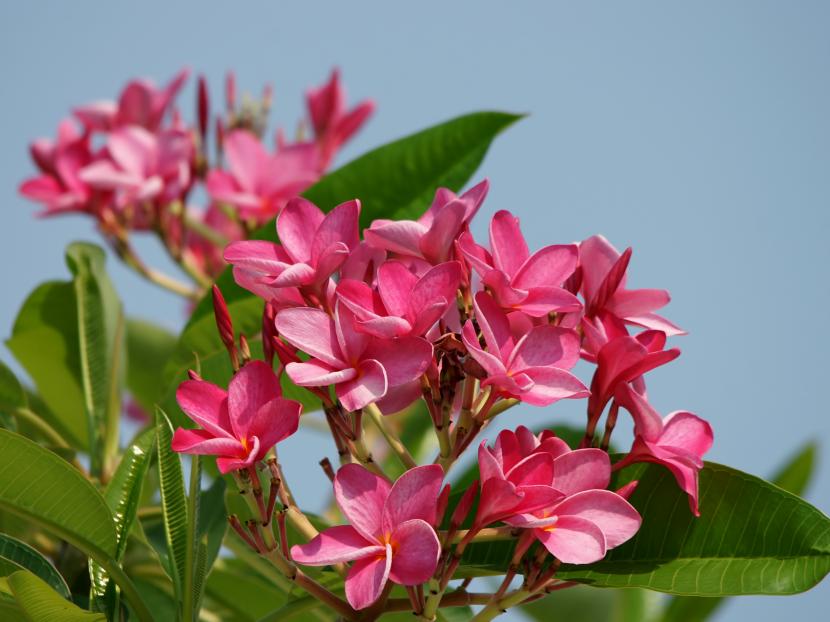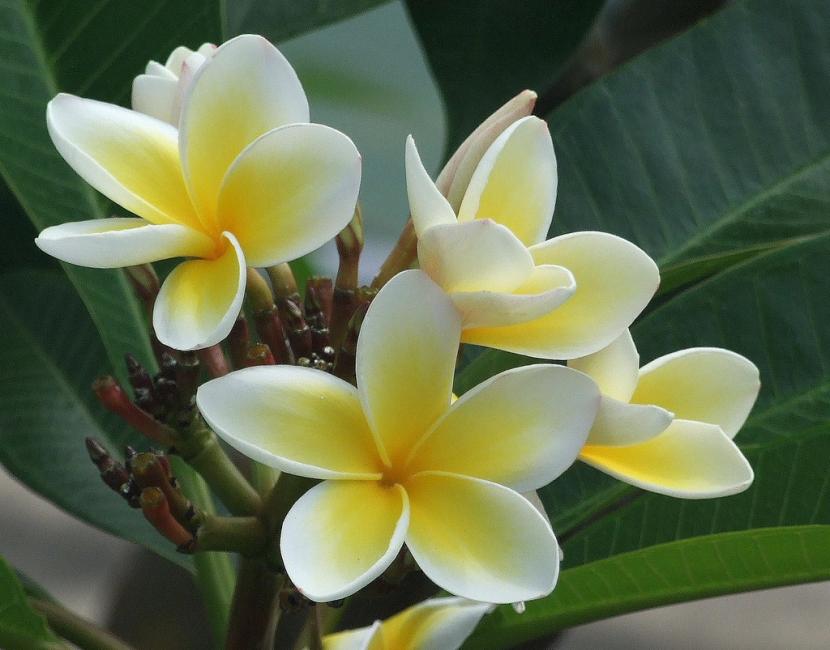
La red plumeria or also known by the name of Frangipani, it is a shrub or small tree of tropical origin that is cultivated in all warm regions around the world, and in slightly cooler climates its extraordinary beauty is used to decorate the home during the warmer months. cold.
It is a very popular plant that needs specific care to make it look beautiful and healthy throughout the year. If you want to discover all its secrets, do not take your eyes off your monitor: I will explain what needs to be done to make it grow and develop without any problem.

Our protagonist can reach a height of about 9m, but in cultivation it rarely exceeds 4-5m. The leaves are deciduous, which means that they are dropped in fall / winter. Its beautiful flowers, which can be pink or white, fragrant are undoubtedly the attraction of this plant, and sprout in spring or early summer.
La red plumeria it is very sensitive to cold, so it can be grown outside only in warm climates. Still, I have to tell you something: the acutifolia variety withstands low temperatures quite well. Of course, as it is a plant of tropical origin, we cannot ask much of it, but it can endure with hardly any damage down to -2ºC, as long as they are short-lived frosts.

Where do you put it? Whether you want to have it on the patio or at home, you have to find a sunny / bright corner. It does not like semi-shade too much, and in fact its flowering will be poor. During the colder months it is convenient to protect it from inclement weather if you have it in an area where frosts are frequent.
In general, these plants have a tendency to rot if they are planted in a very compact substrate, so it is highly recommended to mix black peat and perlite in equal parts, and put a first layer of volcanic clay of about 3cm inside the pot. It must be kept drier than humid, that is, we will water twice a week in summer, and 2-1 / week the rest of the year. You can take advantage of it to fertilize it throughout the growing season -from spring to early autumn- with a liquid organic fertilizer, such as guano for example.
And if you want to have a new plant, in spring you can make cuttings with leaves of about 20cm, impregnate their base with rooting hormones and plant them in perlite or, better, vermiculite. In about two to three weeks you will have a new seedling of red plumeria.
Do you have any at home?
All flowering plants are insane. I like them all! What are the indoor plants for apartments; Small spaces? I would like you to tell me… Thank you very much in advance Melia Gutierrez
Hello Melia.
Here are several suggestions. Click here.
A greeting.
Hello, I bought a plumeria and transplanted it in the garden of my house, there the sun gave him about 8 hours a day but he got sad and I realized that the root never hit the ground and I put it back in a pot with dirt and manure. The leaves have already died and the trunks feel between limp and hard. Could it still be reborn or do I give it up for dead? Please help me… I really like it.
Hello Ana.
I recommend planting it in a pot with a very porous substrate, such as river sand or similar.
This will give you a better chance of recovery.
A greeting.
Good Morning! My sick plumeria! Its leaves are stained since it caught a very small spider. Spray but now it is the trunk that looks softer and the leaves sad. What I can do?
Hello Cristina.
I recommend you suspend the irrigation. Do it again when the soil is very dry (you can check the humidity by inserting a thin wooden stick to the bottom: if it comes out clean, you can water).
You can add rooting hormones to it to help it further.
If it continues to get worse, write to us again and we will tell you.
A greeting.
I can't get the plumeria cutting that was given to me. The leaves are withered …… they told me it was excess water. But nothing…..
Hi Mery.
For a Plumeria cutting to take root it has to be planted in a substrate that drains very well, such as vermiculite. And watered very little: no more than 2 times a week.
A greeting.
HELLO GOOD AFTERNOON ESTIMATED, I TELL YOU THAT I HAVE A TREE LIKE THAT IN MY HOUSE ABROAD AND IT ATTRACTS A LOT OF FLIES FROM THE BIG BIG ... I HAVE ALREADY FUMIGATED IT AND THE NEXT DAY THE FLIES GET AGAIN…. HELP ME NO LONGER KNOW WHAT TO DO I LOVE TREES AND I WOULD NOT LIKE TO HAVE TO CUT IT FOR HEALTH ...
Hello isbael.
Have you looked to see if it has any pests -apart from flies-?
I would recommend treating it with a universal insecticide (they are sold like this, with that name).
Another option is to make a fly trap, with a 5l plastic bottle and melted sugar. I leave you link on how to make a wasp trap, since the steps to follow are practically the same.
A greeting.
Hello
Do plumeria roots damage buildings?
Hi Esther.
No, plumeria roots are not invasive.
Greetings.
wave. I have plumerias, stick a bug that rói as folhas e também cochonilha. I have gotten from universal insecticide, I added poison for cochonulha, I wash the plant, and I remove a different scene of the bug, which clings to the throne and folhas, cor castanha. As flowers last little, fall, mostly ainda em botaão. is ~ inside the house not winter and the fora will not see. Can you help me? pleasant
Hello Anabela.
For mealybugs it is important to use specific insecticides (that is, an anti-mealybug, like this one they sell here), since the universals are usually not effective, since these parasites have a shell that protects them.
Another product that can help you is the diatomaceous earth. This is a white powder made from algae that contains silica, so it is completely natural. When this dust comes in contact with the insect, it causes it to die of dehydration. The way to apply it is as follows:
-First, you have to wet the plant with water;
-and then sprinkle diatomaceous earth over it.
Regards!
Hello, in my house in Cuba we had two in the garden and in the neighborhood almost everyone had this beautiful tree, having said that I do not remember at all that my grandfather gave it a special treatment of course it is your natural habitat I now live in Fuerteventura and I was amazed to find it in the nursery so I bought one, here the climate is perfect, there is only a lack of water but I take care of that in a tropical plan because winter is almost nil
My question after all that has been said is: it has a central trunk and three branches that came out because I accidentally broke the tip in the transfer I would like to know if I do the same again in the incipient shoots would more branches come out without the need for cut it?
Hi, Tony.
Yes that's how it is. If you cut its stems a little, it will bring out new ones lower down.
regards